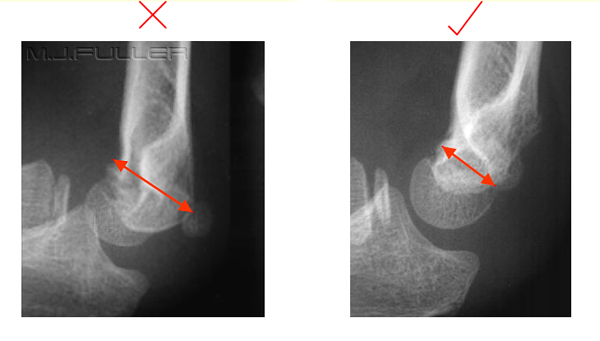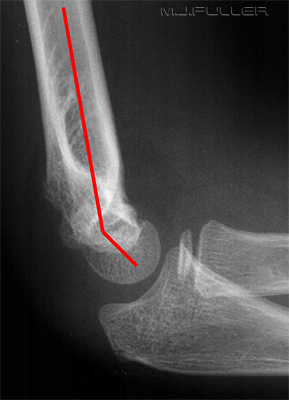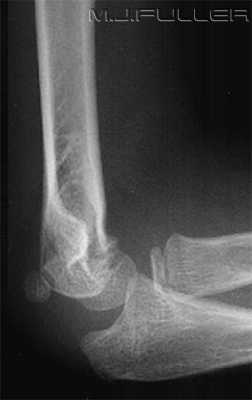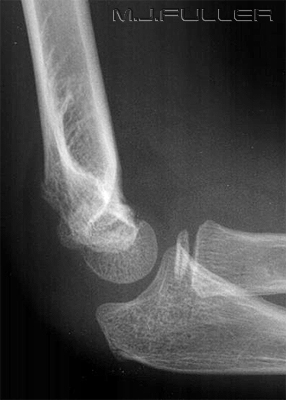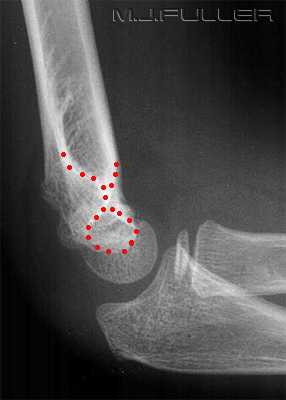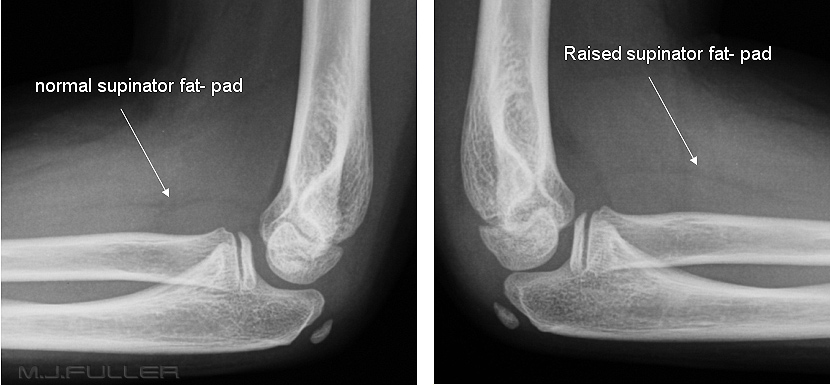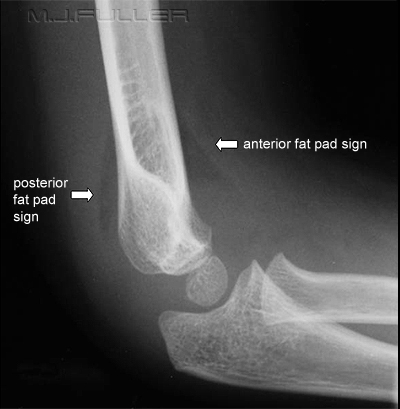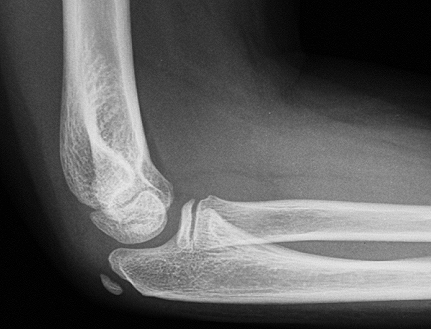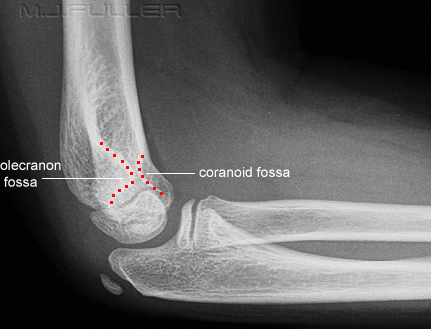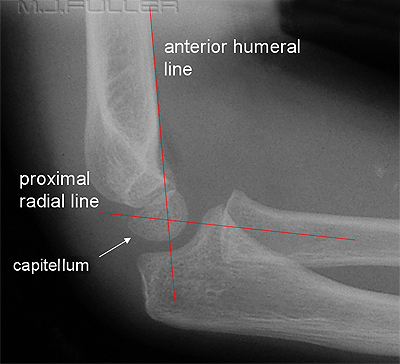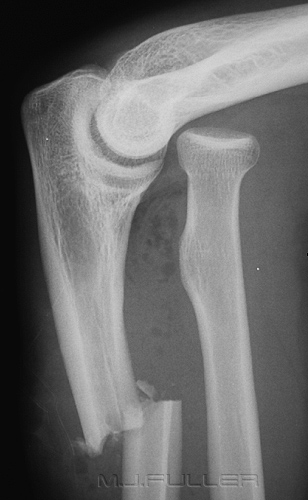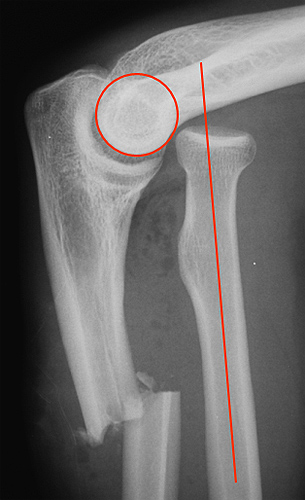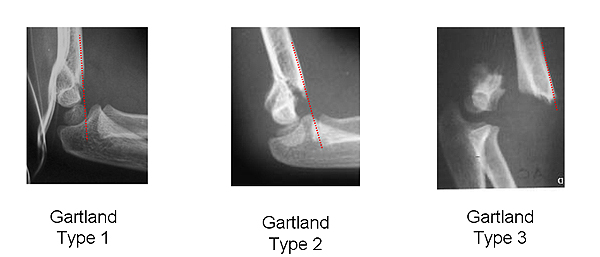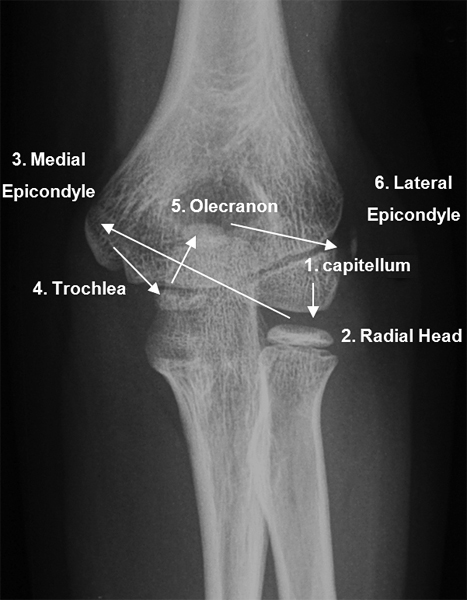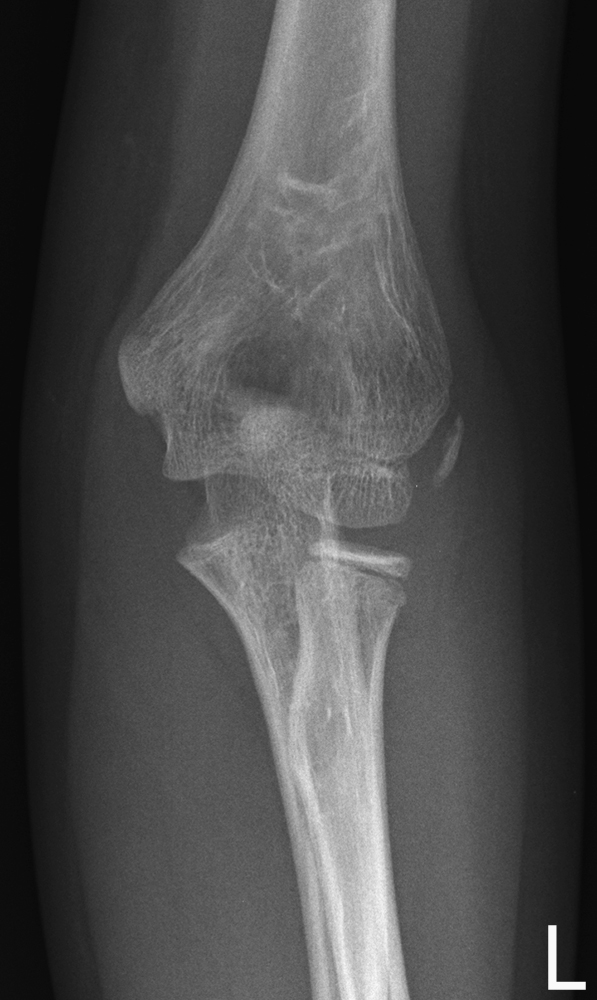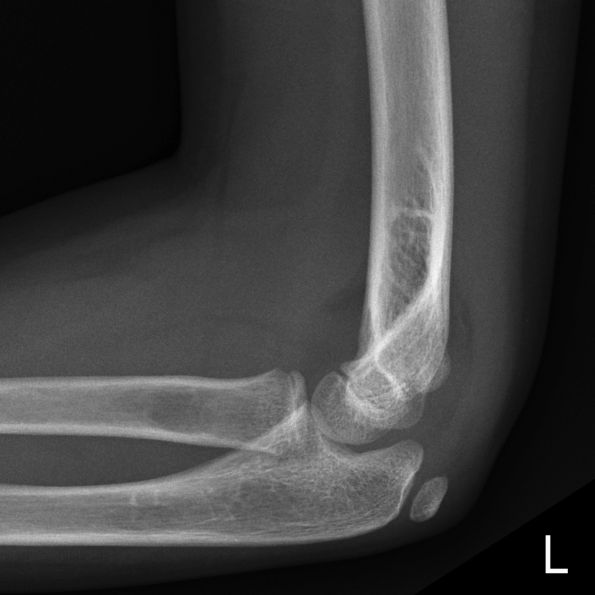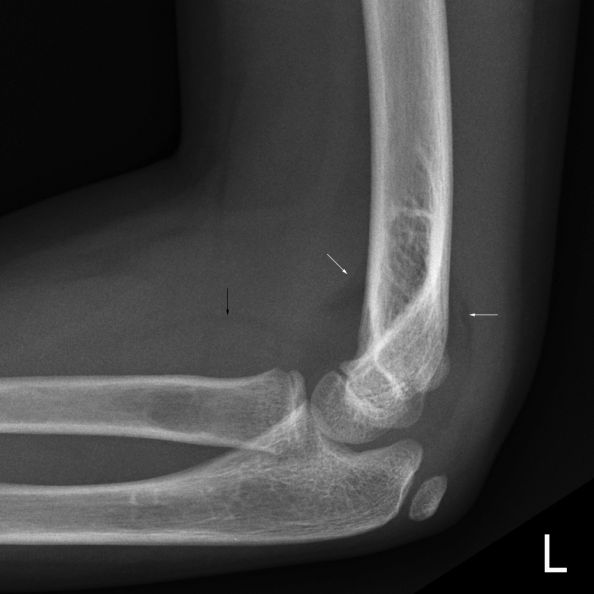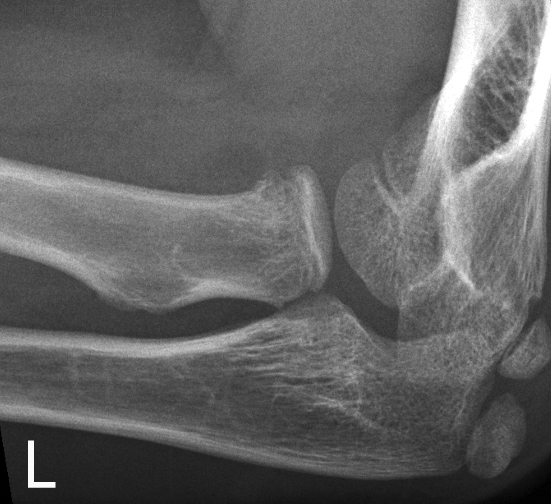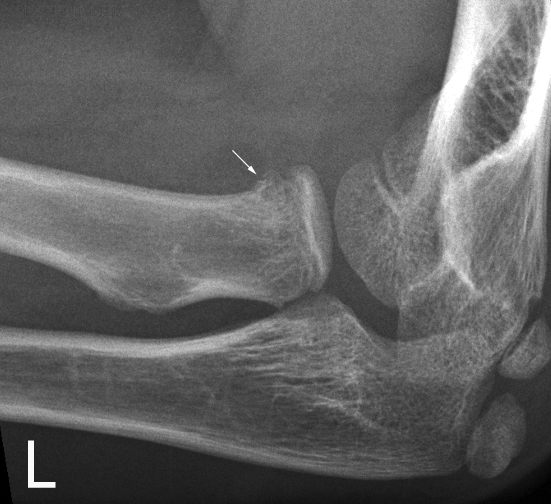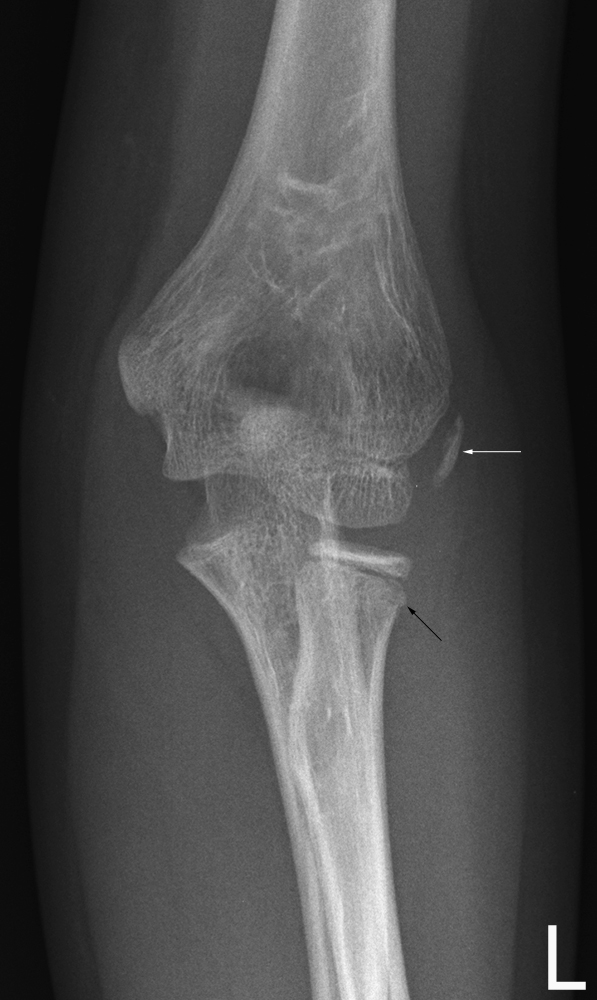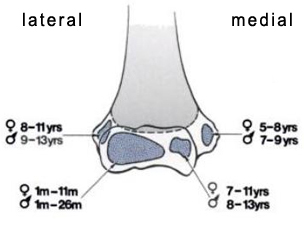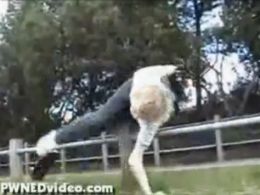The Paediatric Elbow
In many respects paediatric elbow radiography can be a challenge. A perfect lateral elbow projection can be difficult to achieve and this difficulty is exacerbated in a child who is scared and in pain. This page looks at what you are trying to achieve and what to look out for.
The Lateral Elbow
Minimal Antero-posterior (AP) DistanceThe lateral elbow projection, paediatric or adult, is one of the most difficult views in radiography. If you have achieved the correct position, the elbow will be flexed to 90 degrees, the patient's wrist will be in the lateral position, and the distal humerus will have a minimum antero-posterior dimension. The distal humerus is wider in its lateral dimension than in its AP dimension. Therefore, if you start with a perfectly lateral elbow, and you rotate it off lateral, the distal humerus it will increase in its AP dimension. In other words, a true lateral elbow will demonstrate the distal humerus at its narrowest.
The Hockey Stick Analogy
The lateral elbow has been likened to a hockey stick shape as shown left.
Whilst it is undeniable that this lateral elbow looks hockey stick-shaped, this is not a useful aid in assessing lateralness. A lateral elbow can be very "off-lateral" and still retain the hockey stick shape.
The Figure Eight or Hour Glass Sign
The Supinator Fatpad Sign
ImportantThe figure eight sign does not indicate a perfectly positioned lateral elbow. However, the absence of the figure eight sign could indicate that the elbow is not lateral, or that the elbow is fractured, or both.
Tip: Supinator or Pronator Memory Aid?
</a>
<a class="external" href="http://globalvillagebrisbane.files.wordpress.com/2008/12/waiter_-_cartoon_4.jpg" rel="nofollow" target="_blank">Adapted from http://globalvillagebrisbane.files.wordpress.com/2008/12/waiter_-_cartoon_4.jpg</a>
If you have trouble remembering whether it is the supinator fat pad sign or the pronator fat pad sign, think of a restaurant waiter. Waiters sometime carry soup bowls (i.e. "soupinator") in their elbows.
..... pronator fat pad at the wrist.... supinator fat pad at the elbow.
The Fat Pad Sign
Anatomy
Abnormal Proximal Radial Line Elbow Alignment
Abnormal Anterior Humeral Line Elbow Alignment
The CRITOL Rule
The appearances of the ossification centres of the elbow frequently causes confusion. The CRITOL rule is a memory aid that lists the order of appearance of the elbow ossification centres
The order of appearance of the elbow ossification centres is as follows1. Capitellum
2. Radial Head
3. Internal (medial epicondyle)
4. Trochlea
5. Olecranon
6. Lateral Epicondyle
The capitellum contributes to the growth of the humerus and is therefore considered an epiphysis. The other ossifications centres are called traction epiphyses or apophysis.
Some Important Notes about the CRITOL Rule
- It is not uncommon for the ossification centres to appear out of order
- The ages at which the ossification centres appear is approximate only. Different texts will suggests different ages
- The trochlea often appears fragmented- this is normal
- the "I" in CRITOL refers to the medial epicondylar ossification centre
Case 1
Discussion
The SHII fracture (black arrow) was demonstrated on the AP elbow projection image (albeit subtle).
Is the white arrowed structure
The radiographer considered it to be a normal structure; the referring doctor considered it to be a normal structure; the orthopaedic surgeon considered it to be an avulsion fracture; the radiology registrar considered it to be normal and so did the consultant radiologist.. they cant all be correct!
- a normal lateral apophysis?
- an avulsed lateral apophysis?
- an lateral epicondylar avulsion fracture?
CRITOL Rule
<a class="external" href="http://books.google.com.au/books?id=6AXkE4y1678C&pg=PA509&lpg=PA509&dq=radial+head+fractures+incidence+in+adults&source=bl&ots=JRFuoZ23Kh&sig=r6wMfpmEAfwn6_ySqvaTdogcJVk&hl=en&ei=u_FHSvmRIIfU7AOqkZnoAw&sa=X&oi=book_result&ct=result&resnum=9" rel="nofollow" target="_blank">Charles A. Rockwood, Kaye E. Wilkins, James H. Beaty, James R. Kasser
Rockwood and Wilkins' fractures in children
Lippincott Williams & Wilkins, 2006</a>The application of the CRITOL rule suggests an avusion fracture. The lateral ossification centre should follow the ossification of the trochlea. The trochlea is not yet convincingly ossified (although may show early signs). The elbow ossification centres are known to ossify out of order.The lateral ossification centre should appear in the 8-11 agegroup. This child is 9 years old.
Mechanism of Injury
<a class="external" href="http://www.radiologyassistant.nl/en/4214416a75d87" rel="nofollow" target="_blank">http://www.radiologyassistant.nl/en/4214416a75d87</a>
Soft Tissue SignsThe mechanism of injury was a fall. It is possible that the child attempted to break her fall with an outstretched hand. This mechanism would explain the proximal radius fracture. This mechanism is consistent with an avulsion of the medial epicondyle not the lateral epicondyle.
The soft tissues adjacent to the lateral epicondyle appear normal. Elbow avulsion fractures in children should demonstrate associated changes in the adjacent soft tissues.
... back to the Applied Radiography home page
